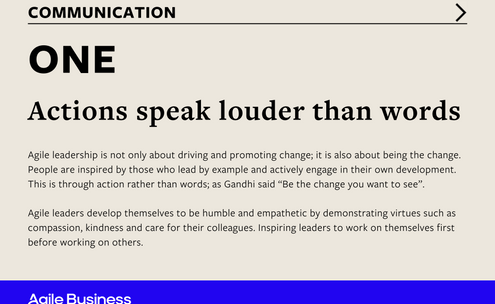What is Productivity Theatre?
‘Productivity theatre’, or ‘appearing busy’, sees employees and even leaders engaging in activities that may look impressive, but often don’t add any real value or achieve any meaningful progress. This theatre plays out in endless meetings and excessively detailed progress reports from team members that add no value to a project. People may try to look or feel busy by constantly checking emails or social media — a distraction from more important tasks, or by multi-tasking — something which, ironically, increases the likelihood of lower quality work and reduced efficiency overall.
In a traditional set-up, such busy-ness might be mistaken for diligence, but in an agile environment, it’s seen for what it truly is—a drain on resources and morale.
The Agile Approach to Cutting Through the Noise
So how do agile leaders tackle the issue?
Agile leadership is all about prioritising value-driven work and empowering teams to focus on outcomes rather than outputs. Let’s explore how the 9 Principles of Agile Leadership can help.
1. Actions speak louder than words
As Gandhi said: “Be the change you want to see.” Agile leaders demonstrate the importance of focusing on meaningful tasks through leading by example. Instead of getting bogged down by ’busy work’, they prioritise high-impact activities and encourage their teams to do the same. They show that it’s better to deliver a few high-value outcomes than to appear endlessly occupied with low-priority tasks. They provide the right support and resources to help teams stay focused on delivering that value. Agile leaders act as enablers, removing obstacles that contribute to productivity theatre, for example by minimising the number and duration of meetings, ensuring that those that do take place have a clear purpose and contribute to the team's goals.
2. Improved quality of thinking leads to improved outcomes
Agile leaders value high-quality thinking which will result in meaningful action and believe in allowing thinking time. They promote a culture of continuous improvement by encouraging and empowering employees to suggest and implement changes that enhance productivity and eliminate wasteful, non-value-adding practices. By doing this, they ensure that the team’s efforts are always aligned with the business goals.
3. Organisations improve through effective feedback
By having regular, one-to-one meetings with employees to discuss their progress, challenges, and goals, agile leaders can provide constructive feedback and guidance to help team members work smarter, not harder, and avoid wasting time.
4. People require meaning and purpose to make work fulfilling
Agile leaders focus on building and sharing a common organisational vision and purpose. They need to understand what is in the hearts and minds of their colleagues, and then to unify and align those values into inspired action.
Agile leaders keep the team focused on the bigger picture. By continuously aligning daily tasks with the overarching vision, they help the team avoid the trap of unnecessary work that doesn’t contribute to the organisation’s long-term goals.
5. Emotion is a foundation to enhanced creativity and innovation
Agile leaders inspire others to bring their best selves to their work. They understand that emotion is an important part of the human experience and that when individuals work with their emotions, they achieve more of their potential. Innovation and creativity rely heavily on respect that the agile leader encourages by being accessible, open, honest and transparent, while expecting the same from others.
Perhaps the most powerful tool to combat productivity theatre is inspiration. Agile leaders inspire their teams to strive for excellence, focusing on real productivity that drives success rather than the mere appearance of being busy.
6. Leadership lives everywhere in the organisation and 9. Great Ideas can come from anywhere in the organisation
Change is inevitable, and agile leaders are the catalysts for positive change. They challenge the status quo, encouraging teams to take the lead by discarding outdated practices that contribute to productivity theatre, in favour of more agile and effective approaches.
7. Leaders devolve appropriate power and authority
Empowering teams to make decisions can significantly reduce instances of productivity theatre. When teams have the autonomy to choose how they work, they’re more likely to focus on tasks that matter, rather than those that simply fill time. Micromanagement can stifle creativity and create an environment conducive to productivity theatre. By trusting employees to manage their own work and encouraging a culture of continuous improvement where employees are empowered to suggest and implement changes, productivity can be enhanced and wasteful practices eliminated.
8. Collaborative communities achieve more than individuals
Open communication is key to cutting through the noise of productivity theatre. Agile leaders foster a culture where honest discussions about workload and priorities are key – discussions where employees are encouraged to express concerns, ask for help, and offer suggestions for process improvements. Team members should have no fear of highlighting resource limitations or organisational processes that may be contributing to the problem. This openness leads to more effective collaboration and less time wasted on redundant tasks.
Productivity theatre produces work waste as the focus is on being (or appearing) busy, rather than on completing the right, most impactful, most relevant task to best achieve the organisation’s strategic goals.
By adhering to the 9 Principles of Agile Leadership, leaders can foster a culture where value creation is the priority and the illusion of busy-ness is banished. In doing so, they not only enhance team efficiency but also create a more engaging and fulfilling work environment, and who doesn’t want that?
For more insights into agile leadership and how it can transform your organisation, visit our website or connect with us on LinkedIn.
Please note blogs reflect the opinions of their authors and do not necessarily reflect the recommendations or guidance of the Agile Business Consortium.


